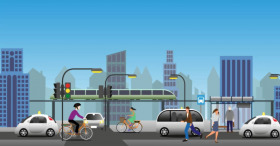- June 27th, 2022
- 0 Comments

The project used data from StreetLight Data to measure auto, foot, and bicycle traffic by tracking movement via data from cellphones and GPS navigation aides to determine where trips start and end. Collected mainly from the pre-pandemic years of 2015-2019, the data shows where people were riding and walking. StreetLight then overlayed the data with maps of where bike and pedestrian accidents occurred, in turn giving the city a better idea of where to prioritize traffic safety measures among 1,300 core roadway miles.
"Remarkably, high-travel shopping, commercial, and educational institution corridors did not necessarily correlate with crash severity. In fact, the most severe crashes occurred in the areas with lower bike and pedestrian traffic," StreetLight's report on the project states. Half of the fatal pedestrian crashes and 51% of total crashes in the period studied were in neighborhoods with low pedestrian activity, it states. For bike crashes, the report found a lack of adequate bike infrastructure, as well as low bike activity correlated with half of the fatal crashes and 36% of the total crashes.
Previously, Pittsburgh relied on old-fashioned data collection methods like rubber hoses on streets, cameras, or head-counts to determine traffic volume, which given resources, only allowed the city to gather data on a few sites at a time and only for a few days.
For planning safety improvements, "most cities look at where they see the biggest number of accidents. But you don't get [the picture] unless you look at traffic volume," explained Martin Morzynski, StreetLight senior vice president of marketing. "Some of the most unsafe streets aren't the busiest ones at all," they could have a hazardous crossing because of an overpass or blind curve. "Sometimes, it is those places that need the fix, such as by adding signals, a sidewalk or something to add visibility," he said.
According to principal transportation planner for Pittsburgh's Department of Mobility and Infrastructure, Panini Chowdhury, the data helps it "to prioritize our project corridors where we are seeing high ped/bike activity and, hence, a good spot fo complete street development." When combined with what the city already knows, the data from this research is helping it choose residential streets that will get traffic calming devices to slow traffic and prioritize pedestrians, bicyclists, and other non-vehicular traffic through its "Neighborways" program. "We have almost two dozen projects in design phase that will get done this year," Chowdhury told Smart Cities Dive.













